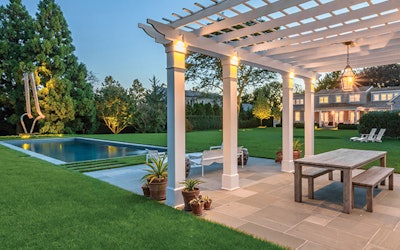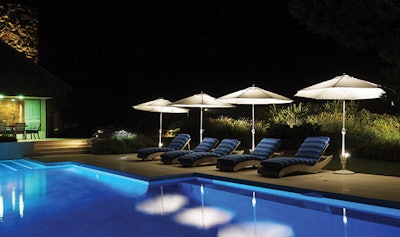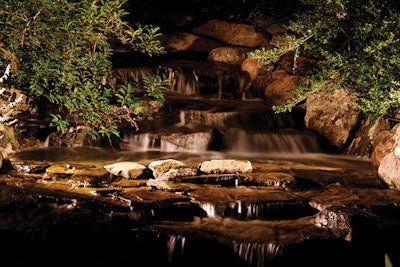
All photos courtesy of Hamptons Landscape Lighting
For landscape lighting designer Scott Armusewicz, Jr., it's all about discovering possibilities after the sun goes down. As lead lighting designer with Hamptons Landscape Lighting (Southampton, N.Y.), Armusewicz says he's always on the lookout for opportunities to create unique effects while also being sensitive to the client's needs.
"It's all about finding that unique piece that will give the client something special, but at the same time give them exactly what they're looking for," he says. "The idea is to look for opportunities to create something that creates a sense of pride of ownership for the client and adds value to the setting."
THE NIGHTTIME EXPERIENCE
Armusewicz reports his projects are often for homeowners who lead busy lives. For many, the presence of a creatively designed lighting system is essential to the value and utility of their outdoor spaces.
RELATED: Light Patterns: A Pool Project With Creative Lighting
"Often the only time people have to enjoy their landscapes is during the hours of darkness because they're working all day," he says. "Yet we also see that many people are very interested in creating environments where they can spend time outside. So the lighting becomes a big part of the outdoor experience. They have these areas where they've spent so much money, the illumination gives them the ability to enjoy it more. That's a big step."
 These unusual illuminated umbrellas proved a perfect solution for a client who wanted to light the pool deck and create attractive focal points in the landscape.
These unusual illuminated umbrellas proved a perfect solution for a client who wanted to light the pool deck and create attractive focal points in the landscape.
As is true of other aspects of landscape design, lighting requires a clear understanding of how clients plan on using their space. A designer with 13 years experience across a range of project types, Armusewicz asks key questions that help him make a range of key decisions, such as which elements to light and which to leave unlit, the number and types of fixtures and the all-important issue of color temperature.
"It's where people go to entertain, so you want to create a living area that invites people outside," he explains. "One of the first questions I ask people is what do they want to do outside. Do they want to entertain? If so, then that will sway me in terms of color temperature, and I might go with cooler lights. Or maybe they want the romantic, intimate type of feeling; then we would use warmer lighting."
ELEMENTS OF ILLUMINATION
The design process includes a number of specific areas that can increase both the aesthetics and utility of outdoor spaces. Illuminating planted areas and hardscapes creates depth and interest and can highlight features within the landscape.
"It might be a specimen planting, or a particular area they really enjoy, a piece of art or just something that's very sentimental," he explains. "Maybe it's the only tree left from the original natural landscape or a piece of art that's been in the family for a long time. It's fun to play with those elements."
By the same token, lighting adds a sense of security and an ability to use the space for practical reasons, such as taking the family dog outside during evening hours, a simple issue that comes up frequently on clients' lists of needs. "When we have clients who need to take their dogs out at night, we'll try to give them a space that's lit for that purpose but still looks aesthetically pleasing and not out of place."
RELATED: The Secret Behind Emotionally Compelling Landscape Design
 Moving water provides unique opportunities to create interest and character in the outdoor space after the sun goes down.
Moving water provides unique opportunities to create interest and character in the outdoor space after the sun goes down.
Other basic elements include pathway lighting, pools, spas, decorative water features and even dock lighting. All are aimed at enhancing décor, creating a greater sense of security and increasing convenience. "Pathway lighting can be very important," he says. "You also want to give people pathways to visually draw their eyes to an area or an object and then provide a way for them to physically move toward it in comfort and safety.
"We had a client recently that had a bench given to her by her grandmother. It was very important to her and was located in a specially designed space. So we lit a pathway back to that location, which became a focal point in the landscape."
Ultimately, he adds, the primary goal is to create illuminated scenes that invite you into the environment. "When people walk into the house, you want them to look out the windows and see the backyard illuminated instead of just a framed piece of blackness, which is what you get without illumination. It's very uninviting. With outdoor lighting you create areas that are intriguing and inviting. They want to go outside and be in that environment. It adds excitement and interest you can't have any other way."
SPECIALTY EFFECTS
Armusewicz is always on the lookout for opportunities to create interesting, unique effects. Lighting water, for example, is among his favorite lighting genres because of the opportunities created by the interplay of light and water.
"Whenever we have moving water in the landscape, we try to take advantage of it," he says. "The constantly changing texture in the reflection of waterfalls, for example, is something you can't achieve any other way. It always draws attention and becomes a key focal point in the environment."
By contrast, reflections in still water also provide unique opportunities to enhance lighting effects. "When a lit object is reflected in water, you're in effect doubling the illumination."
Lighting also offers boundless opportunities for creative applications. Recently, Armusewicz and a fellow lighting designer were working on a project where the homeowner wanted to create illuminated space around the edge of the family's swimming pool. Unfortunately, there were no trees or structures nearby that could be used for mounting light fixtures close enough to the water to light the decks.
"That's when we thought about the umbrellas, which we had seen leaning against the wall in the garage," he recalls. "The caretaker told us that the umbrellas are out all summer so we thought, 'What if we up light those?'"
Armusewicz decided to up light the underside of the umbrellas with a bullet fixture mounted on the umbrella's upright pole, which would illuminate the umbrella's white fabric causing them to glow. "When we lit it up it was more than we expected," he says. "That's a great feeling."
RELATED: Design Inspiration: Make a Statement With Outdoor Lighting
The bullet fixtures include extended vertical shrouds that prevent the fixtures from shining directly into anyone's eyes and they can be easily removed and stored during winter months. When in use, the umbrella lights are connected to in-grade weatherproof boxes that protect the connections. The fixtures also include ample lengths of power cords so the umbrellas can be moved around the deck.
The clients were thrilled with the look of the umbrellas and several other clients have decided to include the unusual fixtures in their projects. "It's like a minimalistic resort," Armusewicz says. "It's a real hit so far. It's an example of using illumination to create something different that makes a beautiful artistic statement."
Lighting SurfacesThe art of landscape lighting often requires a keen understanding of the materials being lit, be they plants, stone, masonry, architectural features or works of art. Knowing the color, texture and reflective qualities of those materials largely governs the type of lighting used, especially the color. According to Armusewicz: "Understanding the colors of the plants or hardscapes that you're trying to illuminate is an important part of the design. For example, in our area we're lighting a lot of evergreens, which traditionally have been lit at 2,700 Kelvin. When you go cool with 3,000 Kelvin, it brings out the greens, where as the warmer temperature brings out the browns. I've found that with red foliage, such as Japanese Maples, even cooler at 4000 Kelvin looks beautiful. But with pathways, I love to go with 2,700 because it's a warm and comforting feel. "Understanding the surface that you're lighting, whether it's a type of stone or a particular type of leaf, it's very, very important in terms of knowing the color temperature that will enhance it the best." |
Comments or thoughts on this article? Please email [email protected]
All photos courtesy of Hamptons Landscape Lighting












































